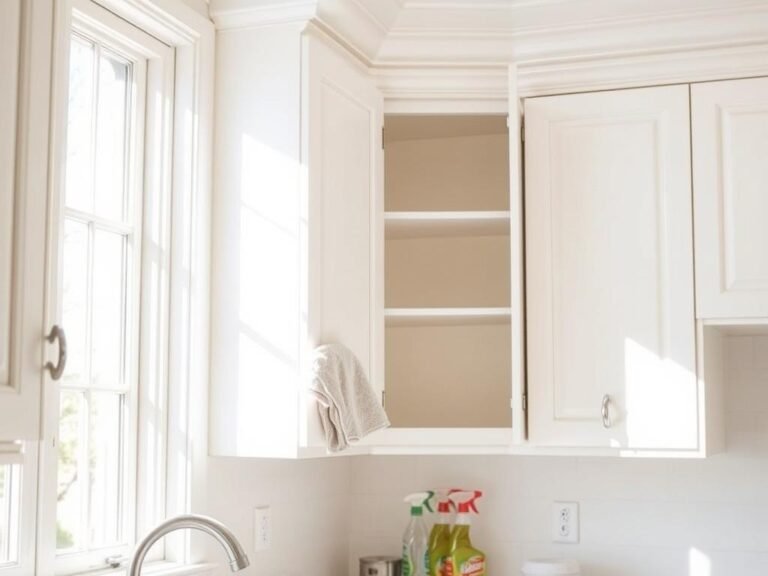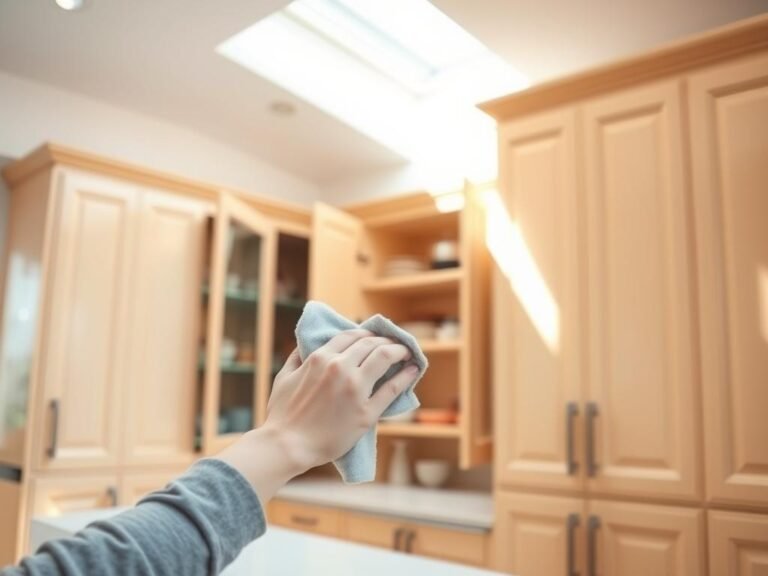Did you know smoke damage can hit up to 100% of kitchen surfaces, including cabinets? This scary fact shows how vital it is to know how to clean smoke off kitchen cabinets well. Smoke residue causes ugly stains and smells that can change your kitchen’s feel. In fact, 60-80% of homeowners say smoke smells linger even after they clean, making it key to clean for looks and health12.
With some smart cleaning tips and tricks, I can make my cabinets look new again. This way, my kitchen will feel fresher and more welcoming.
Key Takeaways
- Smoke damage affects nearly all kitchen surfaces, making thorough cleaning essential.
- Persistent smoke odors are common, indicating the need for effective cleaning methods.
- Proper preparation and protective gear are key to a successful cleaning process.
- Homemade cleaning solutions can effectively tackle smoke residue.
- More than 75% of homeowners face challenges when removing soot.
- Replacing cabinets may be necessary if they show signs of warping or scorching.
The Importance of Cleaning Smoke Residue from Kitchen Cabinets
Cleaning smoke residue from kitchen cabinets is key for looks and health. Smoke residue is sticky and can harm lungs, eyes, and skin3. It makes cabinets look bad and may need a lot of smoke damage restoration to fix.
It’s important to clean smoke quickly to avoid bad smells. These smells can be hard to get rid of, making quick action a must.
When cleaning smoke, you might need to use cleaning agents more than once3. Not cleaning well can damage the cabinets. It’s also important to change HVAC filters after a fire to keep air clean3.
Flat finishes on cabinets might need to be repainted after cleaning3. This is because soot can stain through paint or primer.
The cleaning method can affect how well you get rid of smoke smells. Using strong cleaners like Trisodium Phosphate (TSP) can work well, but be careful not to use it on certain surfaces3. Vinegar or baking soda can also help get rid of smells naturally4.
So, cleaning smoke damage is very important. It’s not just about making things look good. It’s also about keeping everyone healthy and safe.
Understanding Smoke Damage: What You Need to Know
Smoke damage can cause big problems if not fixed fast. Materials like wood and particleboard soak up smoke. This leads to bad smells and stains that are hard to get rid of.
It’s key to know about smoke damage to clean it well. If not treated, it can damage things, change colors, and harm health5. Wooden furniture and painted walls need quick help to avoid lasting stains. They can get damaged in just hours or days5.
Smoke has harmful gases and tiny particles that get into surfaces. This makes it hard to remove stains. Cleaning experts use special methods based on the surface and damage level. Knowing this helps me plan better for cleaning smoke stains6.
Cleaning fast is very important. Not doing it quickly can lead to expensive fixes. Smoke particles, even if you can’t see them, can get stuck in surfaces. This makes things worse over time5. Quick action can prevent big damage and make things cleaner.

Preparing for the Cleaning Process
Effective cleaning starts with careful planning. I find that preparing your workspace is key for a smooth cleaning. This is true, even when cleaning smoke damage on kitchen cabinets. The right supplies and precautions are very important.
Gather Your Supplies
Before starting, I make sure I have all the right supplies. Here’s a list of things I always have:
- Degreasers
- Vinegar and ammonia
- Soft rags
- Protective gloves
- Protective eyewear
I follow kitchen cabinet cleaning tips that suggest using tri-sodium phosphate (TSP). It helps reduce odors in fabrics. A mix of 4 to 6 tablespoons of TSP with 1 cup of household cleaner or chlorine bleach per gallon of warm water is good for cleaning cabinets7.
Protect Yourself and Your Workspace
Safety is very important when cleaning. I wear gloves and eyewear when using strong cleaners. It’s smart to get my workspace ready by moving or covering nearby furniture and appliances to avoid contamination. Good ventilation is key during cleaning to keep safe and remove smoke particles fast8.

How to Clean Smoke Off Kitchen Cabinets
To clean smoke off kitchen cabinets, I start by removing doors and hardware. This makes it easier to clean every part. I also wear protective gear like eye goggles, gloves, and a dust mask to avoid irritation.
Then, I open windows and doors for good ventilation. This helps reduce the amount of airborne irritants. I mix 1/4 cup of degreasing detergent with half a bucket of warm water for cleaning.
For tough stains, I use 1 tablespoon of trisodium phosphate (TSP) in 1 gallon of warm water. This solution is strong against smoke marks. After scrubbing, I rinse with warm water to remove soap residue.
For nicotine or grease stains, a mix of white vinegar and water works well for many users. For strong odors, I mix half a cup of ammonia with a gallon of water. Always test a small area first to avoid damage.
After cleaning, I dry the cabinets with a soft, dry cloth. This helps prevent moisture damage. Simple steps can make a big difference, with many users seeing improvements.
Effective Cleaning Solutions for Smoke Residue
I use strong and easy-to-find cleaning solutions to get rid of smoke residue. I choose between homemade cleaners and commercial ones. Homemade cleaners use things I have at home, while TSP is for tougher smoke damage. These methods help me clean my kitchen cabinets well.
Homemade Cleaners
Making my own cleaners is fun. A mix of white distilled vinegar and water gets rid of smells on hard surfaces. Baking soda is great for fabrics and upholstery, leaving it overnight before vacuuming.
Using vinegar not only cuts down on smells but is also safe for my home.
Using TSP and Other Commercial Cleaners
For hard smoke residue, I use trisodium phosphate (TSP). It’s mixed with 4 to 6 tablespoons per gallon of warm water for cleaning9. This mix breaks down smoke stains and gets surfaces ready for repainting.
A bleach solution of one cup in a gallon of water also fights mold and mildew9. Remember, smoke damage can be hard to remove. Some stains may not come out if not treated fast10. So, using both homemade and commercial cleaners is key to removing smoke and fixing my kitchen.

Step-by-Step Guide to Deep Clean Kitchen Cabinets from Smoke
Deep cleaning kitchen cabinets from smoke can feel like a big task. I suggest following this guide for a thorough clean. First, take off the cabinet doors and hardware to clean all surfaces well. This makes it easier to get to the smoke residue in hard spots.
Removing Cabinet Doors and Hardware
Start by unscrewing the cabinet doors and any hardware. Put these items in a safe place for cleaning later. This step is key for a complete clean. Smoke often sticks to areas behind doors and hinges, making it easier to clean without them.
Washing with Water and Detergent
Then, mix warm water with dish soap. Make sure the solution is between 7 and 8 pH to avoid harming the cabinets11. I use 4 to 6 tablespoons of dish soap for a gallon of warm water. After mixing, I wet a soft cloth and wring it out to avoid too much water.
When washing, start from the top and work down12. For tough smoke marks, a mix of tri-sodium phosphate (TSP) and household cleaner might be needed12. After cleaning, rinse with a damp cloth to remove soap. This gentle washing helps avoid dark stains from alkaline cleaners like ammonia11.

Natural Ways to Clean Smoke Residue
Cleaning smoke residue doesn’t need harsh chemicals. I like using natural methods that are good for the planet. Vinegar is a top pick for cleaning smoke residue. Its acid helps break down dirt and get rid of smells.
Using Vinegar for Cleaning
I mix vinegar and water in a spray bottle. This mix is a strong cleaner. I spray it on smoke residue and wipe with a soft cloth. It cleans well and leaves a nice smell.
Odor Removal Techniques with Baking Soda
Baking soda is great for getting rid of smells. It absorbs smoke smells well. For carpets and furniture, I sprinkle it on and let it sit for eight hours. Then, I vacuum it up. This method makes areas smell fresh again.

Using these natural cleaning methods makes my home look and smell better. It shows how to clean smoke residue naturally without harsh chemicals13.
Final Touches: Ensuring Smoke Smell Removal
In the final phase of cleaning kitchen cabinets hit by smoke, removing the smell is key. The steps I take here are vital for a good clean. Taking care of this part makes the cabinets look new and improves the kitchen.
Drying and Polishing Your Cabinets
After cleaning the cabinets well, drying them is a must. This stops water damage from leftover moisture. I use a soft cloth to dry surfaces, making sure no water stays.
Once dry, I polish the cabinets. This brings back their shine and protects them from dirt.
Additional Techniques for Persistent Odors
Even with careful cleaning and drying, some smoke smells can stay. Air purifiers help get rid of bad smells by cleaning the air. Scented candles also help, adding a nice smell while other methods work.
For extra protection against smells, I might use professional treatments. These treatments target and remove smoke smells completely.
Conclusion
Cleaning smoke residue from kitchen cabinets is more than just making things look good. It’s key to keeping my home healthy and safe. Smoke damage can harm my health and make the air inside worse. Fixing smoke damage quickly makes my kitchen look better and keeps my family safe.
Learning about smoke damage restoration helps me avoid expensive fixes later. Whether I clean it myself or get a pro, knowing the costs helps me plan. With the right tools and knowledge, I can deal with smoke residue and lower risks.
Being proactive with regular cleaning and checks helps prevent smoke damage. By keeping up with cleaning and using good solutions, my kitchen stays clean and welcoming. This keeps it safe from smoke’s bad effects14.




